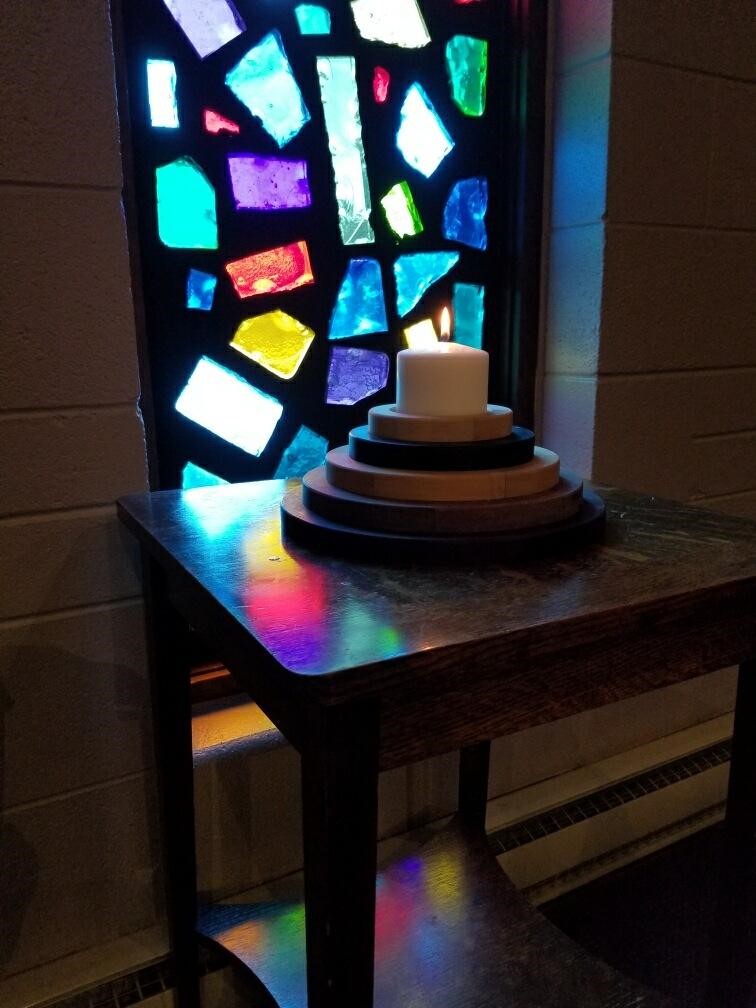Christmas Eve Service | December 24, 2020
Permission to podcast/stream the music in this service obtained through One License with license A-727859
Christmas Eve Worship Service December 24, 2020
The Prelude
Silent night, holy night | Henry Wyse, piano
Joy to the world | Reuben Wyse, piano
Angels we have heard on high | Nina Graber-Nofziger and Katie Graber, violin duet
Go tell it on the mountain | Addy Steiner, xylophone
The Play
Away in a manger | Debra Martin and CMC children, a cappella
O Holy Night | Mira Bixler, cello; Amy Bixler, piano
Christmas Eve Service
Welcome
Candle Lighting
Call to Worship
HWB 212 | O come, all ye faithful | Congregational recording
First Reading | Isaiah 9:2-7 | Ivan Graber-Nofziger
HWB 206 | Infant holy, Infant lowly | Abbie Miller, vocalist; Joel Miller, guitar
Second Reading | Psalm 96 | Ivan Graber-Nofziger
HWB 191 | O little town of Bethlehem | Congregational recording
Third Reading | Titus 2:11-14 | Shakita Kabicek
HWB 197 | Angels we have heard on high | Congregational recording
Fourth Reading | Luke 2:1-20 | Shakita Kabicek
Silence
HWB 199 | The first Noel | Congregational recording
Pastoral Prayer
HWB 193 | Silent night, holy night | Congregational recording; Alexander Martin, violin; Jim Myers, clarinet
Benediction and Sending
Thanks to those who led our service this evening
Children’s Play Directors | Debra Martin and Parents
Children’s Play Video Editor | Elisa Leahy
Music coordination | Phil Hart
Worship leader | Julie Hart
Zoom host | Elisa Leahy
Slides | Gwen Reiser
…
Worship in Place | Christmas 1 | December 27
The video above includes the full service, except for the time for sharing.
Permission to podcast/stream the music in this service obtained through One License with license A-727859
Order of Worship | Christmas 1
Prelude: There’s a baby on my plate | Tom Blosser, accordion & vocals; Galen Martin, guitar & vocals
Welcome
Call to Worship
Peace Candle
HWB 318 | Joy to the World | Galen, Debra, Sarah, & Elizabeth Martin, vocals
Children’s Time
Offering/Dedication Prayer https://www.columbusmennonite.org/donateget-involved/donate
Special Music | We Three Kings | Stella Bixler, flute and Amy Bixler, piano
Scripture | Isaiah 61:10-62:3, Galatians 4:4-7
HYMN | Awake | Written and accompanied on flute by Phil Hart. Vocals by many voices.
Meditation| Austin McCabe Juhnke
Silent Reflection
Meditation | Shirley Miller
Silent Reflection
HYMN | Wake up, it’s Christmas morning | Sung by Becca Lachman; Michael Lachman, piano
Sharing of Joys and Concerns
Pastoral Prayer
Extinguishing the Peace Candle
Benediction
Announcements
Thanks to everyone who helped lead today’s service
Meditations: Austin McCabe Juhnke, Shirley Miller
Worship Leader: Jen Cartmel
Music coordination: Phil Hart
Children’s Time: Jen Cartmel, Bill and Maya Plessinger
Peace Candle: Jen Cartmel
Scripture Reading: Gretchen Geyer
Zoom Host: Elisa Leahy
…
Worship in Place | Awake in the Dark | Advent 4 | December 20
CMC Worship Service 12.22.20 from Gwen Reiser on Vimeo.
The video above includes the full service, except for the time for sharing.
Permission to podcast/stream the music in this service obtained through One License with license A-727859
Order of Worship | December 20, 2020 |Advent 4
Prelude
Welcome
Call to Worship
Peace Candle
STS 11 | No wind at the windows | Phil Hart, Abbie Miller, vocals. Alexander Martin, violin.
Children’s Time
Offering/Dedication Prayer https://www.columbusmennonite.org/donateget-involved/donate
Hymn | Awake | Music and words by Phil Hart. Sung by many voices.
Scripture | Luke 1:26-38
Video | Come to us, Emmanuel | Noonday Films- Elisa and Matthew Leahy
Sermon | Solitude, Solidarity, Salvation Manuscript Below
Scripture Reading | Luke 1:39-45; 46-56
Silent Reflection
HWB 178 | Come thou long expected Jesus | Jacqui and Ryan Hoke, vocals
Sharing of Joys and Concerns
Pastoral Prayer
Extinguishing the Peace Candle
Benediction
Announcements
Christian Education | 11:00 am
Thanks to everyone who helped lead today’s service
Sermon: Joel Miller
Worship Leader: Jennifer Cartmel
Music coordination: Katie Graber
Children’s Time: Diane Mueller
Peace Candle: Adam Glass
Scripture Reading: Stella and Mira Bixler
Zoom Host: Sarah Werner
—————————-
Sermon Manuscript
Watch THIS video
1. Solitude
The world is not a friendly place for an unmarried pregnant teenage girl. Especially when you’re poor. Not in our time. Not in Mary’s time.
The Franklinton neighborhood of Columbus, Ohio, is just as good a place as any to consider this. The Leahys shot the video a number of years ago, and the imagery holds true. Furniture thrown haphazardly in a front yard – a telltale sign of eviction, an abandoned warehouse, a burned out house owned by a slumlord who ignored faulty electrical wiring, barbed wire fences: These are not marks of a hospitable environment into which to birth a child.
But there is life here. There is playfulness. And there is a strong – even unbreakable chord – that connects this story with…
Worship in Place | Awake in the Dark | Advent 3 | Music Sunday | December 13
The video above includes the full service, except for the time for sharing.
Permission to podcast/stream the music in this service obtained through One License with license A-727859
Order of Worship | Awake in the Dark | Advent 3 | Music Sunday
Prelude
Welcome
STS 15 | Hope is a candle | Tom Blosser vocal and piano, Quinn Blosser violin
Call to Worship
Peace Candle
Hymn | Awake | written by Phil Hart, sung by many voices
Advent Candle lighting | The Coble family
Offering/Dedication Prayer https://www.columbusmennonite.org/donateget-involved/donate
Pastoral Prayer
STS 26 | Helpless and Hungry / HWB 215 What Child is this | CMC choir and congregation (2019)
Scripture | Isaiah 64:1-4,8-11, 1 Thessalonians 5:16-24
CMC Choir | recordings from past years
In Dulci Jubilo | German carol 15th century | CMC choir (2016)
Lovey Child, Holy Child | Text and arr. David Johnson/Trad folk melody | CMC choir (2019)
Riu, Riu, Chiu | 16th century Spanish villancico | CMC choir (2016)
STS 28 | Holy Child within a manger | Text and Music: Marty Haugen | CMC choir (2019)
Congregation
HWB 211 | Lo, how a Rose e’er blooming | CMC choir and congregation (2017)
CMC Choir | recordings from past years
HWB 203 | Break forth, O beauteous heav’nly light | Text: Johann Rist/Harmonized by J.S. Bach | CMC choir (2018)
While by my sheep | English text: Theodore Baker/arr. by Hugo Richard Jungst | CMC choir (2018)
Wexford Carol | Traditional Irish, 12th Century, arr. by Elaine Hagenberg | CMC choir (2019)
And the Glory of the Lord | From Messiah by G. F. Handel | CMC choir (2019)
Extinguishing the Peace Candle
Benediction
Announcements
Christian Education | 11:00 am
Thanks to everyone who helped lead today’s service
Worship Leader and Peace Candle: Jennifer Cartmel
Music coordination: Tom Blosser, Phil Hart
Advent Candle: The Coble Family
Scripture Reading: Maya Plessinger, Nancy Franke
Advent Artwork: Elisa Leahy
Zoom Host: Brent Miller
…

Worship in Place | Awake in the Dark | Advent 2 | December 6
The video above includes the full service, except for the time for sharing.
Permission to podcast/stream the music in this service obtained through One License with license A-727859
Order of Worship | Awake in the Dark | Advent 2
Prelude
Welcome
Hymn | Holy Darkness | Martin Family, Tom Blosser, piano
Call to Worship
Peace Candle
As we worship in place today, we light a Peace Candle in our home.
May this flame be a sign of our prayer for peace within us, among us, to the ends of the earth.
The flame joins us in spirit across distance, along with our sister church in Armenia, Colombia.
Hymn | Awake | written by Phil Hart, sung by many voices
Children’s Time
Offering/Dedication Prayer https://www.columbusmennonite.org/donateget-involved/donate
HWB 172 | O come, O come, Immanuel | Martin Family
Scripture | Isaiah 40:1-5; Mark 1:1-8
Sermon | Braving the Dark
Silent Reflection
HWB 183 | On Jordan’s banks the Baptist’s cry | Martin Family
Sharing of Joys and Concerns
Pastoral Prayer
Extinguishing the Peace Candle
Benediction
Announcements
Congregational Meeting | following worship
Baby Shower | following Congregational Meeting
Cookie Sunday | following Baby Shower
Thanks to everyone who helped lead today’s service
Sermon: Mark Rupp
Worship Leader: Jennifer Cartmel
Music coordination: Debra and Galen Martin
Children’s Time: Wyse Family
Peace Candle: Hoke Family
Scripture Reading: Maya Plessinger
Zoom Host: Gretchen Geyer
Sermon Text:
I can’t remember if I’ve shared this with you all yet, but I have a genetic condition known as Autosomal-Dominant Compelling Helioophthalmic Outburst Syndrome. It affects somewhere between 18-35% of the population, so there’s a good chance that you or someone you love is affected as well. But it’s probably a lot scarier than it sounds, especially when you realize that some scientist decided to call it that long string of big words mostly for the acronym, which spell out ACHOO. It’s also sometimes referred to as photoptarmosis, or light sneezing.
The completely unscientific way I like to describe it to people is that I am just a…
